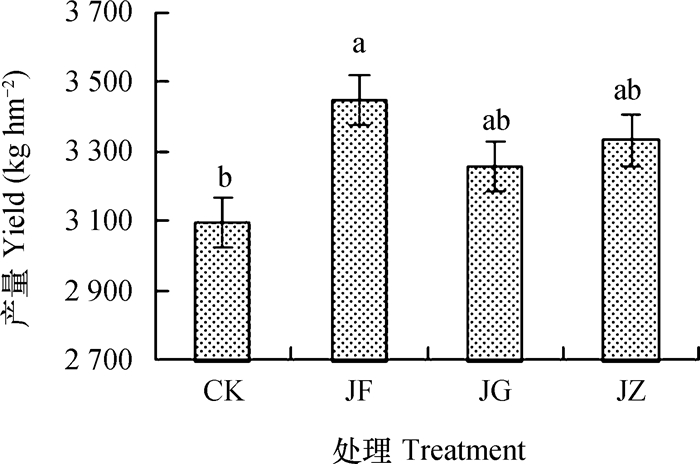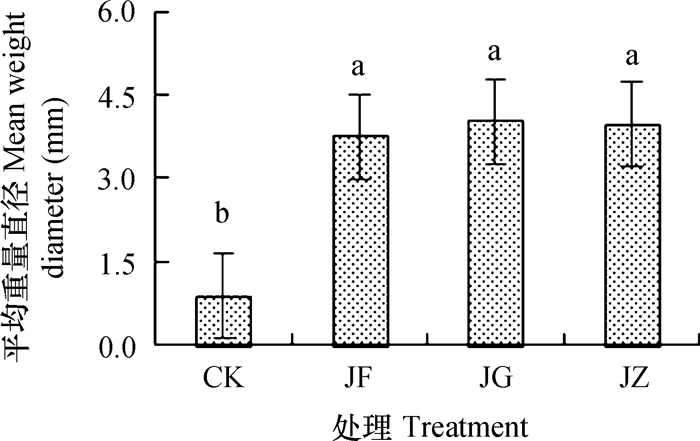中国人多地少,农业的发展扮演着举足轻重的角色。随着科学技术的发展,化肥在农业生产中逐渐被推广使用,并且施用量呈直线上升趋势,在农业生产中占据重要位置。然而对化肥过度依赖和使用,土壤养分下降和板结现象普遍出现。
土壤养分是土壤肥力的重要指标之一,也是决定作物产量的重要因素,对农业生产起到重要作用。土壤肥力是农业可持续发展的基础[1]。土壤团聚体是土壤的基本结构单位,是土壤中能量转化及物质代谢的场所,决定着土壤的诸多性质和肥力。团聚体对协调土壤肥力状况、改善土壤耕性等有着重要作用,影响着土壤孔隙性、持水性和抗蚀性,常被作为衡量土壤肥力水平的重要指标[2]。不同粒级的团聚体在营养元素的保持、供应及转化能力等方面的作用也各不相同。各粒级团聚体的数量分布和空间排列方式决定了土壤孔隙的分布和连续性,进而决定了土壤的水力性质和通透性能,并影响土壤生物的活动和养分的保持与供应[3]。各粒级团聚体的分布对协调土壤水肥气热以及提高土壤通水透气具有重要作用。
大豆是忌重迎茬种植的植物,同一种植区域连续多年种植大豆,会导致产量下降[4]。现有研究表明有机肥与化肥相结合是增加和维持土壤肥力以及提高作物产量的有效方法[5-6],对克服连作障碍增加产量具有良好效果。有机物料是土壤肥力的重要物质基础, 施用有机物料对土壤性质改善及作物生产有着重要影响[7],已有大量关于有机物料培肥土壤的研究报道。宋蒙亚等[8]发现,添加有机物料可以显著提高土壤养分含量。有机物料能提高土壤有机质含量与阳离子交换量,从而提高土壤的保肥、供肥能力[9]。研究表明,施用有机肥能有效提高土壤微生物活性[10],达到改良土壤物理性状、提升土壤有机质含量等效果[11]。崔荣美等[12]通过有机培肥研究发现,在一定范围内,0~20 cm土层水稳性团聚体的平均重量直径与秸秆还田量及有机肥施用量呈正相关。Lu等[13]研究发现,6%稻壳生物炭不仅显著提高变性黏土2~5 mm和0.25~0.5 mm大团聚体含量,同时又可以减小<0.25 mm微团聚体含量,显著提高了平均重量直径和几何平均直径。孙元宏等[14]研究发现,秸秆的添加,促进了土壤中小粒径团聚体(<0.25 mm)向大团聚体(>0.25 mm)的转化。
然而,前人的研究多集中于单一类型有机物料,且大多数有机物料为玉米秸秆[15],而关于腐熟鸡粪(JF)、玉米秸秆(JG)、木耳菌渣(JZ)等不同类型的有机物料对土壤肥力和团聚体稳定性影响的研究还未见报道。本研究以畜禽粪便类的腐熟鸡粪(JF)、天然类的玉米秸秆(JG)、半腐解类的木耳菌渣(JZ)三种不同类型的有机物料为研究对象,探究其对连作大豆土壤养分及其对土壤团聚体组成的影响,为有机物料培肥土壤提供理论依据。
1 材料与方法 1.1 供试材料试验在吉林农业大学教学实验田进行,土壤类型为黑土,种植品种为吉农18。腐熟鸡粪(JF),取自吉林农业大学动物科学与技术学院;玉米秸秆(JG)和木耳菌渣(JZ)均取自吉林农业大学培养场。试验前供试耕层土壤及各有机物料基础数据见表 1。
|
|
表 1 试验材料基础数据 Table 1 Basic data of the materials tested |
设4个处理,分别为:(1)腐熟鸡粪+化肥(JF);(2)玉米秸秆+化肥(JG);(3)木耳菌渣+化肥(JZ);(4)化肥(CK),空白对照。
本试验采用小区试验,起始于2010年,为长期定位试验。每小区8垄,垄距0.65 m,垄长5 m,面积为25 m2。不同处理间每垄施用等量化肥(磷酸二铵60 g、氯化钾45 g),同时施入相当于烘干重的有机物料0.75 kg,空白只施用化肥不施用有机物料。采用垄沟沟底施用,先施化肥后施有机物料,覆盖薄土压实后种植。3次重复。
1.3 研究方法土样采集在大豆(2016年9月)收获期进行,五点取样法采土2 kg。去除杂质,将大块掰碎后在通风处晾干,取500 g进行团聚体干筛试验,并按各粒级比例取50 g用于湿筛试验;另取部分研磨过筛后测定土壤养分。碱解氮采用碱扩散法,速效磷采用钼锑抗比色法,速效钾采用火焰光度法,有机质采用重铬酸钾氧化法, 具体方法参考鲍士旦《土壤农化分析》[16]。土壤团聚体采用沙维诺夫法测定,具体方法见刘孝义《土壤物理及土壤改良研究法》[17]。
土壤团聚体平均重量直径(MWD)的计算公式为:
| $ \text{MWD}=\sum\limits_{i=1}^{n}{{{B}_{i}}{{W}_{i}}} $ | (1) |
式中,Bi为筛分出来的任一大小范围团聚体的平均直径,Wi为任一大小范围团聚体的相应质量占土壤样品干质量的分数。
对于干筛的团聚体,将n个粒径范围以内的干筛团聚体百分含量Xn构成矩阵:
| $ {{X}_{n}}=\left\{ {{X}_{1}}, {{X}_{2}}, {{X}_{3}}, \cdots, {{X}_{n}} \right\} $ | (2) |
湿筛后所对应土壤团聚体百分含量Yn构成矩阵:
| $ {{Y}_{n}}=\left\{ {{Y}_{1}}, {{Y}_{2}}, {{Y}_{3}}, \cdots, {{Y}_{n}} \right\} $ | (3) |
假设团聚体筛径依次为1,2,3,…,n,在筛分过程中,每个筛径的团聚体能保留在对应筛径范围内的几率分别为P1,P2,P3,…,Pn,而团聚体破裂进入下一个筛径的几率为1-P1,1-P2,1-P3,…,1-Pn,则Xn与Yn之间就可建立以下关系
| $ \left\{ \begin{align} &{{X}_{1}}{{P}_{1}}={{Y}_{1}}, \\ &{{X}_{1}}\left( 1-{{P}_{1}} \right){{P}_{2}}+{{X}_{2}}{{P}_{2}}={{Y}_{2}}, \\ &{{X}_{1}}\left( 1-{{P}_{1}} \right)\left( 1-{{P}_{2}} \right){{P}_{3}}+{{X}_{3}}{{P}_{3}}={{Y}_{3}}, \\ &\vdots \\ &{{X}_{1}}\left( 1-{{P}_{1}} \right)\left( 1-{{P}_{2}} \right)\left( 1-{{P}_{n-1}} \right){{P}_{n}}+ \\ &{{X}_{2}}\left( 1-{{P}_{2}} \right)\left( 1-{{P}_{n-1}} \right)+\cdots +{{X}_{n}}{{P}_{n}}={{Y}_{n}} \\ \end{align} \right. $ | (4) |
计算各个粒径团聚体保存几率之和,即为土壤团聚体稳定性指数(Aggregate Stability Index, ASI):
| $ \text{ASI}={{P}_{1}}+{{P}_{2}}+{{P}_{3}}+{{P}_{4}}+\cdots +{{P}_{n}} $ | (5) |
利用WPS 2016软件进行数据整理,用SPSS 18.0软件对数据进行LSD检验和单因子、双因子方差分析。
2 结果与讨论 2.1 不同有机物料对连作大豆土壤养分的影响图 1可以看出,在大豆连作过程中有机物料的施用可以显著提高土壤中碱解氮含量,土壤中碱解氮含量均高于CK。JF和JZ处理达到土壤碱解氮含量均高于CK,JF处理极显著水平;不同有机物料处理间有差异,排列次序为JF>JZ>JG。

|
图 1 不同有机物料对土壤养分的影响 Fig. 1 Soil nutrient contents relative to treatment 注:JF代表腐熟鸡粪,JG代表玉米秸秆,JZ代表木耳菌渣。不同字母表示差异显著(p<0.05)。下同Note: JF stands for composted chicken droppings; JG for corn stalk; and JZ for fungi residue. Different letters in the same column represent significant difference(p<0.05). The same below |
JG能提高连作大豆土壤中速效磷的含量。JZ对土壤中速效磷提高效果不及JG,JF最低。
有机物料对连作大豆土壤中速效钾含量具有提高作用。JF能显著增加连作大豆土壤中速效钾的含量;JZ处理次之,土壤中速效钾含量高于CK处理,但效果不显著;JG处理速效钾含量低于CK。
有机物料能有效增加连作大豆土壤中有机质的含量,各处理间对连作大豆土壤有机质含量的影响有差异,增加效果由高到低依次为JG>JZ>JF。
2.2 不同有机物料对连作大豆土壤微生物生物量的影响由图 2可知,JZ对土壤中微生物生物量碳提高效果最显著;JF和JG也能有效提高土壤中微生物生物量碳含量,但不如JZ效果明显。JF对提高土壤中微生物生物量氮含量效果极显著;与CK相比,JG和JZ也达到显著效果。JG对土壤中微生物生物量磷提高效果显著,JF和JZ处理微生物生物量磷含量也明显高于CK。JG和JZ能有效提高微生物代谢熵,JF处理最低。

|
图 2 不同有机物料对土壤微生物量的影响 Fig. 2 Soil microbial biomass relative to treatment |
图 3可以看出,CK处理产量最低,JF处理产量最高,为3 418.3 kg hm-2,较CK处理提高13.5%,JG和JZ处理较CK分别提高9.0%和6.2%。由此可见,JF对提高产量效果显著,JG和JZ处理也能有效提高产量,但不显著。不同类型有机物料处理间存在差异,但差异不显著。有机物料处理产量均高于CK,由高到低依次为JF>JZ>JG>CK。

|
图 3 湿筛条件下不同有机物料对产量的影响 Fig. 3 Crop yield relative to treatment by wet sieve |
图 4可以看出所有有机物料处理土壤团聚体平均重量直径均显著高于CK,且差异显著。JG处理的土壤团聚体平均重量直径最大,各处理土壤团聚体平均重量直径从高到低依次为JG>JZ>JF>CK,较CK分别增加358.0%、351.1%、326.1%。不同类型有机物料处理间存在一定差异,但差异不显著。

|
图 4 湿筛条件下不同有机物料对土壤团聚体平均重量直径的影响 Fig. 4 Mean weight diameter of soil aggregates relative to treatment by wet sieve |
各处理的不同粒径土壤团聚体测定结果见表 2,利用式(4)和式(5)求得各级粒径的保存几率和稳定性指数,结果如表 3所示。由于湿筛法所用最小筛孔为0.25 mm, 在湿筛法测定团聚体过程中粒径小于0.25 mm的团聚体不能再破裂为更小的粒径,因此粒径小于0.25 mm的团聚体的保存几率均为1。因为在团聚体湿筛过程中,0.25 mm为最小筛径,湿筛时粒径小于0.25 mm团聚体不可能再破裂为较小粒径的团聚体,而粒径大于0.25 mm团聚体均会存在土壤颗粒破裂现象,因此粒径大于0.25 mm团聚体的保存几率均小于1。
|
|
表 2 不同有机物料处理土壤团聚体的组成 Table 2 Composition of soil aggregates relative to treatment(%) |
|
|
表 3 不同有机物料处理土壤团聚体的保存几率及稳定性指数 Table 3 Preservation probability and stability index of soil aggregates relative to treatment |
在各有机物料处理中,除了粒径小于0.25 mm的团聚体的保存几率均为1以外,JF、JG、JZ及CK其他粒径团聚体的最大保存几率分别为0.841、0.835、0.850、0.445。除大于5 mm团聚体保存几率CK处理略高于JF和JZ处理外,所有有机物料处理的其余各粒级土壤团聚体保存几率均明显高于CK。CK处理0.25~1 mm团聚体的保存几率占土壤团聚体稳定性指数的84.50%,大于1 mm的团聚体仅占18.48%,JF、JG和JZ处理大于1 mm团聚体分别占土壤团聚体稳定性指数的29.52%、38.97%、29.07%,明显高于CK。由此可见,添加有机物料的能明显增加大于1 mm水稳性团聚体的保存几率,对提高土壤团聚体稳定性具有重要意义。
将平均重量直径与大于0.25 mm的团聚体含量进行线性拟合,二者呈极显著正相关,相关系数高达0.99。
由表 3可以看出,所有有机物料处理的土壤团聚体稳定性指数均高于CK,JG处理土壤团聚体的稳定性指数最高,为4.293,明显高于CK处理。所有处理土壤团聚体稳定性指数由高到低分别为:JG(4.293)>JZ(3.788)>JF(3.720)>CK(2.262)。由此可见,有机物料的施入可以有效增加土壤团聚体的稳定性。
3 讨论 3.1 不同有机物料对连作大豆土壤养分及产量的影响有机物料对提高连作大豆土壤中碱解氮、速效磷、速效钾和有机质含量效果显著,土壤养分含量高于单施化肥。本研究选取的三种不同类型有机物料中的JF对碱解氮的提高作用最为显著,较CK提高13.85%;其次是JZ,提高7.82%;JG提高3.59%,但不显著;JG对提高速效磷含量作用最显著,较CK提高4.13%;其次是JZ,提高3.64%。JF提高土壤中速效钾含量的效果最高,较CK提高8.97%;这与陈安强等[18]、王芳等[19]的研究结果一致;JG对提高土壤有机质效果最好,较CK提高7.28%,与宋蒙亚[20]的研究结果一致。本研究中JF处理全磷含量高,但在结果中土壤速效磷含量较JG处理低,这可能是由于JF腐解周期短,磷的释放比较集中,腐解过程中产生的磷被固定到土壤中,而JG和JZ腐解周期长,释放速率低能有效转化为速效磷所致。JG处理的土壤中速效钾含量低于其他处理,可能是JG腐解过程缓慢,释放速率低造成的。有机物料还能有效提高土壤中微生物量碳含量,JZ效果显著,JF和JG较CK有一定的提高, 但效果不显著;JF对提高土壤中微生物生物量氮含量效果极显著,JG和JZ也达到显著水平,有机物料对提高连作大豆土壤微生物生物量氮含量效果显著;JG对提高土壤中微生物生物量磷效果显著,JF和JZ较CK也能有效提高微生物生物量磷含量,但效果不显著;JG和JZ对提高土壤微生物代谢熵效果显著, 与张赛等[21]研究结果一致,但JF处理微生物代谢熵低于CK。Dilly和Munch[22]研究表明,土壤微生物代谢熵的变化能够指示土壤微生物种群利用土壤有机质的效率,qCO2值升高表明土壤微生物活性降低及土壤养分利用效率下降,qCO2降低表明土壤微生物碳利用效率提高。本研究,JF处理微生物代谢熵低于CK,这可能是JF易腐解,土壤中微生物碳利用效率较高,也可能是JF处理微生物活性较高所致。在本研究中,有机物料对连作7年大豆土壤中养分含量的提高均有良好的效果,JG处理综合效果最好。
有机物料能有效提高连作大豆产量,JF效果显著,JG和JZ较CK相比也能提高连作大豆产量,但效果不显著。本研究发现,连作大豆产量与碱解氮含量呈显著正相关关系,这与严君等[23]研究结果一致。本研究中,所有有机物料处理产量均高于CK。由此可见,有机物料能有效克服大豆连作过程中出现的减产问题,提高产量,对于克服大豆连作障碍具有重要意义。
3.2 不同有机物料对连作大豆土壤团聚体组成及稳定性的影响有机物料能有效增加土壤团聚体平均重量直径,这与马晓丽[24]、赵亮[25]的研究结果一致;杜立宇等[26]研究发现,对连作大豆土壤团聚体平均重量直径提高作用最明显的为JG处理, 三种不同类型的有机物料对土壤团聚体平均重量直径提高由高到低依次为JG>JZ>JF。三种类型有机物料对提高土壤中大于1 mm团聚体含量效果均较显著,JF、JG和JZ处理1 mm以上团聚体分别占土壤团聚体稳定性指数的29.52%、38.97%、29.07%。由此可见,长期施用有机物料具有促进水稳性微团聚体向水稳性大团聚体形成的趋势。土壤中粒径大于0.25 mm团聚体的含量越多,团聚体的平均重量直径越大,土壤结构也越稳定。本研究中,所有有机物料处理的0.25 mm以上团聚体粒径团聚体保存几率与稳定性指数均明显高于CK处理,这表明有机物料的施入能有效提高土壤团聚体的稳定性,土壤结构的水稳性也得到了提高。由此可见,有机物料对提高连作大豆土壤团聚体平均重量直径,增加土壤团聚体的水稳性具有良好效果。三种类型的有机物料均能有效提高土壤团聚体稳定性,其中JG效果最好,较CK提高89.79%,所有处理土壤团聚体稳定性指数由高到低依次为:JG(4.293)>JZ(3.788)>JF(3.720)>CK(2.262)。由此可见,有机物料的加入能有效提高连作大豆土壤中团聚体水稳性。与刘恩科等[27],化肥与有机肥配施处理可提高水稳性大团聚体含量, 改善土壤团聚体的结构,研究结果一致。
4 结论三种不同类型有机物料均能有效提高连作大豆土壤中碱解氮、速效磷、速效钾以及有机质的含量,提高养分含量,并且效果显著。畜禽粪便类的JF对提高连作大豆土壤碱解氮、速效钾和产量效果最显著;天然类的JG对提高连作大豆土壤中速效磷和有机质含量效果最显著;半腐解类的JZ对提高连作大豆土壤微生物生物量碳和微生物代谢熵效果最显著。三种类型有机物料均能明显提高连作大豆土壤中大粒径团聚体的含量,增加水稳性团聚体平均重量直径,显著增加土壤团聚体的稳定性指数。
| [1] |
黄东风, 王利民, 李卫华, 等. 培肥措施培肥土壤的效果与机理研究进展. 中国生态农业学报, 2014, 22(2): 127-135. Huang D F, Wang L M, Li W H, et al. Research progress on the effect and mechanism of fertilization measure on soil fertility (In Chinese). Chinese Journal of Eco-Agriculture, 2014, 22(2): 127-135. (  0) 0) |
| [2] |
严波, 贾志宽, 韩清芳, 等. 不同耕作方式对宁南旱地土壤团聚体的影响. 干旱地区农业研究, 2010, 28(3): 58-63. Yan B, Jia Z K, Han Q F, et al. Effects of different tillage on soil aggregates in the arid areas of South Ningxia (In Chinese). Agricultural Research in the Arid Areas, 2010, 28(3): 58-63. (  0) 0) |
| [3] |
刘中良, 宇万太. 土壤团聚体中有机碳研究进展. 中国生态农业学报, 2011, 19(2): 447-455. Liu Z L, Yu W T. Review of researches on soil aggregate and soil organic carbon (In Chinese). Chinese Journal of Eco-Agriculture, 2011, 19(2): 447-455. (  0) 0) |
| [4] |
Liu X B, Li Y S, Han B J, et al. Yield response of continuous soybean to one-season crop disturbance in a previous continuous soybean field in Northeast China . Field Crops Research, 2012, 138(10): 52-56.
(  0) 0) |
| [5] |
Aguilera J, Motavalli P P, Gonzales M A, et al. Initial and residual effect of organic and inorganic amendments on soil properties in a pato-based cropping system in the Bolivian Andean Highlands . American Journal of Experimental Agriculture, 2012, 2(4): 641-666. DOI:10.9734/AJEA
(  0) 0) |
| [6] |
Bandyopadhyay K K, Misra A K, Ghosh P K, et al. Effect of integrated use of farmyard manure and chemical fertilizers on soil physical properties and productivity of soybean . Soil and Tillage Research, 2010, 110(1): 115-125. DOI:10.1016/j.still.2010.07.007
(  0) 0) |
| [7] |
李建明, 吴景贵. 不同有机物料对土壤和环境影响差异性的研究进展//中国环境科学学会. 中国环境科学学会学术年会论文集, 北京: 中国环境科学学会, 2013: 6403-6410 Li J M, Wu J G. The research progress of different organic materials on soil and environmental impact(In Chinese)//China Environmental Science Society. Proceedings of the China Environmental Science Association. Beijing: China Environmental Science Society, 2013: 6403-6410 (  0) 0) |
| [8] |
宋蒙亚, 李忠佩, 刘明. 不同有机物料组合对土壤养分和生化性状的影响. 中国农业科学, 2013, 46(17): 3594-3603. Song M Y, Li Z P, Liu M. Effects of mixtures of different organic materials on soil nutrient content and soil biochemical characteristics (In Chinese). Scientia Agricultura Sinica, 2013, 46(17): 3594-3603. DOI:10.3864/j.issn.0578-1752.2013.17.008 (  0) 0) |
| [9] |
赵亮, 刘存寿. 不同有机物料对土壤肥力及团聚体稳定性的影响. 西北农林科技大学学报(自然科学版), 2013, 41(2): 130-144. Zhao L, Liu C S. Effects of different organic materials on soil fertility and aggregates stability (In Chinese). Journal of Northwest A & F University(Natural Science Edition), 2013, 41(2): 130-144. (  0) 0) |
| [10] |
王笃超, 吴景贵, 李建明. 不同有机物料对连作大豆土壤养分含量及生物性状的影响. 水土保持学报, 2017, 31(3): 258-262. Wang D C, Wu J G, Li J M. Effects of different organic materials on soil nutrient contents and biological properties of continuous cropping of soybean (In Chinese). Journal of Soil and Water Conservation, 2017, 31(3): 258-262. (  0) 0) |
| [11] |
Ding X, Yuan Y, Liang Y, et al. Impact of long-term application of manure, crop residue, and mineral fertilizer on organic carbon pools and crop yields in a Mollisol . Journal of Soils and Sediments, 2014, 14(5): 854-859. DOI:10.1007/s11368-013-0840-x
(  0) 0) |
| [12] |
崔荣美, 李儒, 韩清芳, 等. 不同有机培肥对旱作农田土壤团聚体的影响. 西北农林科技大学学报(自然科学版), 2011, 39(11): 124-132. Cui R M, Li R, Han Q F, et al. Effect of different organic manure with fertilization on soil aggregates in dry farmland (In Chinese). Journal of Northwest A&F University(Natural Science Edition), 2011, 39(11): 124-132. (  0) 0) |
| [13] |
Lu S G, Sun F F, Zong Y T. Effect of rice husk biochar and coal flyash on some physical properties of expansive clayey soil(vertisol) . Catena, 2014, 114: 37-44. DOI:10.1016/j.catena.2013.10.014
(  0) 0) |
| [14] |
孙元宏, 高雪莹, 赵兴敏, 等. 添加玉米秸秆对白浆土重组有机碳及团聚体组成的影响. 土壤学报, 2017, 54(4): 1009-1017. Sun Y H, Gao X Y, Zhao X M, et al. Effects of corn stalk incorporation on organic carbon of heavy fraction and composition of soil aggregates in albic soil (In Chinese). Acta Pedologica Sinica, 2017, 54(4): 1009-1017. (  0) 0) |
| [15] |
幕平, 张恩和, 王汉宁, 等. 不同年限全量玉米秸秆还田对玉米生长发育及土壤理化性状的影响. 中国生态农业学报, 2012, 20(3): 291-296. Mu P, Zhang E H, Wang H N, et al. Effects of continuous straw return to soil on maize growth and soil chemical and physical characteristics (In Chinese). Chinese Journal of Eco-Agriculture, 2012, 20(3): 291-296. (  0) 0) |
| [16] |
鲍士旦. 土壤农化分析. 北京: 中国农业出版社, 2000. Bao S D. Agricultural chemistry analysis for soil (In Chinese). Beijing: China Agriculture Press, 2000. (  0) 0) |
| [17] |
刘孝义. 土壤物理及土壤改良研究法. 上海: 上海科学技术出版社, 1982: 11-47. Liu X Y. Soil physical and soil improvement method (In Chinese). Shanghai: Shanghai Science and Technology Press, 1982: 11-47. (  0) 0) |
| [18] |
陈安强, 付斌, 鲁耀, 等. 有机物料输入稻田提高土壤微生物碳氮及可溶性有机碳氮. 农业工程学报, 2015, 31(21): 160-167. Chen A Q, Fu B, Lu Y, et al. Organic materials enter rice fields to improve soil microbial carbon nitrogen and soluble organic carbon nitrogen (In Chinese). Transactions of the Chinese Society of Agricultural Engineering, 2015, 31(21): 160-167. DOI:10.11975/j.issn.1002-6819.2015.21.021 (  0) 0) |
| [19] |
王芳, 张金水, 高鹏程, 等. 不同有机物料培肥对渭北旱塬土壤微生物学特性及土壤肥力的影响. 植物营养与肥料学报, 2011, 17(3): 702-709. Wang F, Zhang J S, Gao P C, et al. Effects of application of different organic materials on soil microbiological properties and soil fertility in Weibei rainfed highland (In Chinese). Plant Nutrition and Fertilizer Science, 2011, 17(3): 702-709. DOI:10.11674/zwyf.2011.0425 (  0) 0) |
| [20] |
宋蒙亚. 不同有机物料组合对物料分解及土壤生化性状的影响. 南京: 南京农业大学资源与环境学院, 2013. Song M Y. Effects of mixtures of different organic materials on its decomposition and soil (In Chinese). Nanjing: College of Resources and Environmental Science, Nanjing Agricultural University, 2013. (  0) 0) |
| [21] |
张赛, 王龙昌, 张晓雨, 等. 紫色土丘陵区保护性耕作下旱地土壤呼吸及影响因素. 土壤学报, 2014, 51(3): 520-530. Zhang S, Wang L C, Zhang X Y, et al. Respiration of upland soil under conservation tillage in purple hilly regions and its influencing factors (In Chinese). Acta Pedologica Sinica, 2014, 51(3): 520-530. (  0) 0) |
| [22] |
Dilly O, Munch J C. Microbial biomass content, basal respiration and enzyme activities during the course of decomposition of leaf litter in a black alder (Alnus glutinosa (L.) Gaertn) forest . Soil Biology & Biochemistry, 1996, 28: 1073-1081.
(  0) 0) |
| [23] |
严君, 韩晓增, 丁娇, 等. 东北黑土区大豆生长、结瘤及产量对氮、磷的响应. 植物营养与肥料学报, 2014, 20(2): 318-325. Yan J, Han X Z, Ding J, et al. Responses of growth, nodulation and yield of soybean to different nitrogen and phosphorus fertilization management (In Chinese). Journal of Plant Nutrition and Fertilizer, 2014, 20(2): 318-325. DOI:10.11674/zwyf.2014.0207 (  0) 0) |
| [24] |
马晓丽. 旱作区有机培肥对土壤理化性状及冬小麦生长的影响. 陕西杨凌: 西北农林科技大学资源与环境学院, 2010: 17-18. Ma X L. Effect of organic fertilization on physiochemical characters of soil and growth of winter wheat in arid areas (In Chinese). Yangling, Shaanxi: College of Resources and Environment, Northwest Agriculture and Forestry University, 2010: 17-18. (  0) 0) |
| [25] |
赵亮. 不同有机物料对土壤肥力的影响. 陕西杨凌: 西北农林科技大学资源与环境学院, 2012. Zhao L. Effect of different organic materials on soil fertility (In Chinese). Yangling, Shaanxi: College of Resources and Environment, Northwest Agriculture and Forestry University, 2012. (  0) 0) |
| [26] |
杜立宇, 李天来, 梁成华, 等. 长期不同施肥处理对设施土壤团聚体组成及其稳定性的影响. 水土保持通报, 2012, 32(1): 38-41. Du L Y, Li T L, Liang C H, et al. Effects of long-term different fertilizations on composition and stability of soil aggregates in greenhouse soil (In Chinese). Bulletin of Soil and Water Conservation, 2012, 32(1): 38-41. (  0) 0) |
| [27] |
刘恩科, 赵秉强, 梅旭荣, 等. 不同施肥处理对土壤水稳定性团聚体及有机碳分布的影响. 生态学报, 2010, 30(4): 1035-1041. Liu E K, Zhao B Q, Mei X R, et al. Distribution of water-stable aggregate sand organic carbon of arable soils affected by different fertilizer application (In Chinese). Acta Ecologica Sinica, 2010, 30(4): 1035-1041. (  0) 0) |
 2018, Vol. 55
2018, Vol. 55


